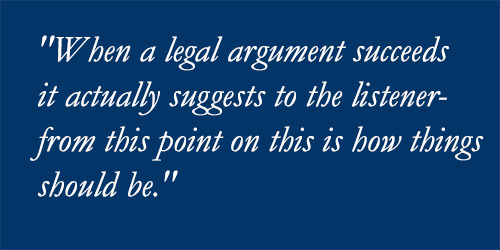 It has been said that lawyers do not produce anything. Well, actually they do. They produce arguments—reasons why their client should prevail. Some evaluate legal arguments based solely on their outward appearance—how convincing do they sound? But there are other ways to evaluate the soundness of a legal argument. These include asking:
It has been said that lawyers do not produce anything. Well, actually they do. They produce arguments—reasons why their client should prevail. Some evaluate legal arguments based solely on their outward appearance—how convincing do they sound? But there are other ways to evaluate the soundness of a legal argument. These include asking:
How strong is its internal structure? A legal argument should have a strong endoskeleton. It should be solid, well-built: supported by fact and layered with persuasive reasons. It should be internally strong; that is, its reasoning should fit tight within its confines. It should be internally consistent; that is, it should use the materials at hand in a way that does not create contradiction or inconsistency. And there’s a certain feel to a strong argument—it feels inescapable, unavoidable, as if preordained. For example, a jury argument is based in part on testimonial evidence and it makes a difference whether the evidence actually supports the conclusion sought to be drawn. There can’t be a gap. If one is seeking to prove negligence, the evidence needs to show that somewhere there was a negligent act—not merely a reasonable act that led to an adverse outcome.
How strong is its external structure? A legal argument should have a strong exoskeleton. It should be able to withstand a strong cold wind blowing in from the north. It should be able to survive on its own amidst the maelstrom of other competing arguments. And it should be resilient, able to weather the storm. From a distance, it should look solid, impregnable. It should be capable of standing alone: a well-built artifact which can be admired from a distance. And of course legal arguments do create outcomes—and outcomes matter. The outcomes sought should be optimal, desirable, ones that can be appreciated, even applauded. And not only do outcomes matter, but appearances matter as well. A legal argument should be aesthetically pleasing. Its elements should click into place with the precision of a lock. It should have its own harmony, symmetry. Its final appearance should seem natural, as if everything has taken its rightful place.
Can the rule derived from the argument be universalized? Legal reasoning sometimes uses a method where similarities between cases are recognized, and a general rule is deduced from these cases which is then applied to a new case. If this method is employed, the rule derived should be one capable of being universalized. If it cannot, the argument probably needs to be reformulated.
Finally, does it track the past, and does it have the power to shape the future? Both are required. The former links to what’s gone before; the latter, to what’s to come after. The area between these two—nebulous, indeterminate—can best be described as the zone where legal arguments can grow and flourish. And those who create the strongest legal arguments are those capable of making this zone appear unbroken, uniform, and seamless. For ultimately a legal argument serves as nothing more than a bridge between two worlds—the past and future. The past represents what has been; the future, what should be. When a legal argument succeeds it actually suggests to the listener—from this point on this is how things should be. And, with only the slightest gesture of assent, the future arrives.




